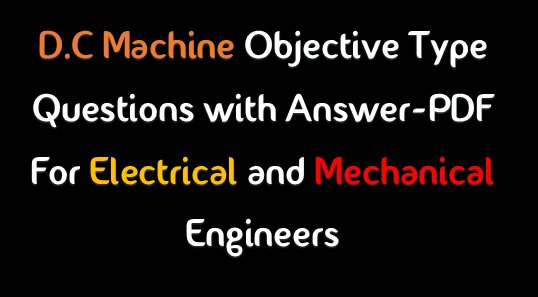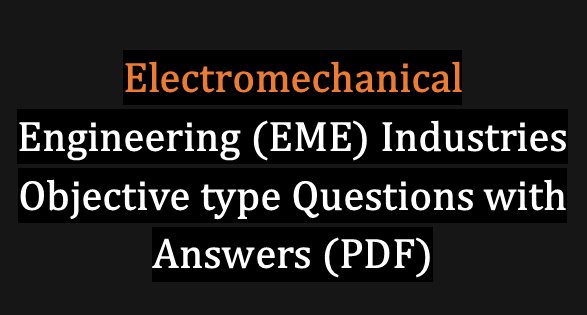Control System Electrical Objective Questions and Answers(PDF)
Control System Electrical MCQs Objective Questions and Answers(PDF)
1.The temperature, under thermal and electrical system analogy, is considered analogous to
(a) voltage
(b) current
(c) capacitance
(d) charge
(e) none of the above
Ans: a
2.In electrical-pneumatic system analogy the current is considered analogous to
(a) velocity
(b) pressure
(c) air flow
(d) air flow rate
Ans: d
3.In liquid level and electrical system analogy, voltage is considered analogous to
(a) head
(b) liquid flow
(c) liquid flow rate
(d) none of the above
Ans: a
4.The viscous friction co-efficient, in force-voltage analogy, is analogous to
(a) charge
(b) resistance
(c) reciprocal of inductance
(d) reciprocal of conductance
(e) none of the above
Ans: b
5.In force-voltage analogy, velocity is analogous to
(a) current
(b) charge
(c) inductance
(d) capacitance
Ans: a
6.In thermal-electrical analogy charge is considered analogous to
(a) heat flow
(b) reciprocal of heat flow
(c) reciprocal of temperature
(d) temperature
(e) none of the above
Ans: d
7.Mass, in force-voltage analogy, is analogous to
(a) charge
(b) current
(c) inductance
(d) resistance
Ans: c
8.In a stable control system backlash can cause which of the following ?
(a) Underdamping
(b) Overdamping
(c) Poor stability at reduced values of open loop gain
(d) Low-level oscillations
Ans: d
9.In an automatic control system which of the following elements is not used ?
(a) Error detector
(b) Final control element
(c) Sensor
(d) Oscillator
Ans: d
10.In a control system the output of the controller is given to
(a) final control element
(b) amplifier
(c) comparator
(d) sensor
(e) none of the above
Ans: a
11.A controller, essentially, is a
(a) sensor
(b) clipper
(c) comparator
(d) amplifier
Ans: c
12.The capacitance, in force-current analogy, is analogous to
(a) momentum
(b) velocity
(c) displacement
(d) mass
Ans: d
13.Which of the following devices are commonly used as error detectors in instruments ?
(a) Vernistats
(b) Microsyns
(c) Resolvers
(d) Any of the above
Ans: d
14.Which of the following should be done to make an unstable system stable ?
(a) The gain of the system should be decreased
(b) The gain of the system should be increased
(c) The number of poles to the loop transfer function should be increased
(d) The number of zeros to the loop transfer function should be increased
Ans: b
15.increases the steady state accuracy.
(a) Integrator
(b) Differentiator
(c) Phase lead compensator
(d) Phase lag compensator
Ans: a
16.A.C. servomotor resembles
(a) two phase induction motor
(b) Three phase induction motor
(c) direct current series motor
(d) universal motor
Ans: a
17.As a result of introduction of negative feedback which of the following will not decrease ?
(a) Band width
(b) Overall gain
(c) Distortion
(d) Instability
Ans: a
18.Regenerative feedback implies feedback with
(a) oscillations
(b) step input
(c) negative sign
(d) positive sign
Ans: d
19.The output of a feedback control system must be a function of
(a) reference and output
(b) reference and input
(e) input and feedback signal
(d) output and feedback signal
Ans: a
20.is an open loop control system.
(a) Ward Leonard control
(b) Field controlled D.C. motor
(c) Stroboscope
(d) Metadyne
Ans: b
21.A control system with excessive noise, is likely to suffer from
(a) saturation in amplifying stages
(b) loss of gain
(c) vibrations
(d) oscillations
Ans: a
22.Zero initial condition for a system means
(a) input reference signal is zero
(b) zero stored energy
(c) ne initial movement of moving parts
(d) system is at rest and no energy is stored in any of its components
Ans: d
23.Transfer function of a system is used to calculate which of the following ?
(a) The order of the system
(b) The time constant
(c) The output for any given input
(d) The steady state gain
Ans: c
24.The band width, in a feedback amplifier.
(a) remains unaffected
(b) decreases by the same amount as the gain increase
(c) increases by the sane saaaajajt as the gain decrease
(d) decreases by the same amount as the gain decrease
Ans: c
25.On which of the following factors does the sensitivity of a closed loop system to gain changes and
load disturbances depend ?
(a) Frequency
(b) Loop gain
(c) Forward gain
(d) All of the above
Ans: d
26.The transient response, with feedback system,
(a) rises slowly
(b) rises quickly
(c) decays slowly
(d) decays quickly
Ans: d
27.The second derivative input signals modify which of the following ?
(a) The time constant of the system
(b) Damping of the system
(c) The gain of the system
(d) The time constant and suppress the oscillations
(e) None of the above
Ans: d
28.Which of the following statements is correct for any closed loop system ?
(a) All the co-efficients can have zero value
(6) All the co-efficients are always non-zero
(c) Only one of the static error co-efficients has a finite non-zero value
(d) None of the above
Ans: c
29.Which of the following statements is correct for a system with gain margin close to unity or a phase margin close to zero ?
(a) The system is relatively stable
(b) The system is highly stable
(c) The system is highly oscillatory
(d) None of the above
Ans: c
30.Due to which of the following reasons excessive bond width in control systems should be avoided ?
(a) It leads to slow speed of response
(b) It leads to low relative stability
(c) Noise is proportional to band width
(d) None of the above
Ans: c
Download PDF
Follow and Join our Facebook Group Page & Social Site to Get Update daily.
Facebook Group Page Twitter Google Plus
3 Comments
Add a Comment
You must be logged in to post a comment.



Welder questions
Welder question
Electrical & Electronics MCQ Question & Ans. for Asst. Eng. job exam